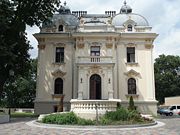
Institute of the Lithuanian Language
Encyclopedia

Vilnius
Vilnius is the capital of Lithuania, and its largest city, with a population of 560,190 as of 2010. It is the seat of the Vilnius city municipality and of the Vilnius district municipality. It is also the capital of Vilnius County...
is a state-supported research organization that focuses on research into the Lithuanian language
Lithuanian language
Lithuanian is the official state language of Lithuania and is recognized as one of the official languages of the European Union. There are about 2.96 million native Lithuanian speakers in Lithuania and about 170,000 abroad. Lithuanian is a Baltic language, closely related to Latvian, although they...
.
History
The origins of the institute can be traced to the editorial commission Academic Dictionary of LithuanianAcademic Dictionary of Lithuanian
Academic Dictionary of Lithuanian is the complete thesaurus of the Lithuanian language and is one of the most extensive lexicographical pieces in the world....
, founded by Professor Juozas Balčikonis
Juozas Balcikonis
Juozas Balčikonis was a Lithuanian linguist and teacher, who contributed to the standardization of the Lithuanian language.- References :...
in 1930. As an outgrowth of this commission, the Antanas Smetona Institute for Lithuanian Studies was founded in 1939. This institute's goal was to research the Lithuanian language.
After the Soviet occupation of Lithuania in 1941, the Antanas Smetona Institute for Lithuanian Studies and the Lithuanian Society of Science were merged into the Institute of the Lithuanian Language, within the greater framework of the Academy of Sciences. The Institute experienced difficulties during this period; a number of prominent linguists had emigrated, there was ideological pressure to employ Marxist language theory, and contacts with the international scholarly community were curtailed. In 1952 it was merged with the Institute of Lithuanian Literature. In April 1990 the Institute regained its status as an independent institution.
Structure and activities
The Institute consists of four departments (Language History and Dialectology, Onomastics, Grammar, and Language Culture), two centers (Terminology and Lexicography), and a publishing house. Institute is active in academic fields of linguisticsLinguistics
Linguistics is the scientific study of human language. Linguistics can be broadly broken into three categories or subfields of study: language form, language meaning, and language in context....
, lexicology
Lexicology
Lexicology is the part of linguistics which studies words, their nature and meaning, words' elements, relations between words , word groups and the whole lexicon....
, lexicography
Lexicography
Lexicography is divided into two related disciplines:*Practical lexicography is the art or craft of compiling, writing and editing dictionaries....
, grammar
Grammar
In linguistics, grammar is the set of structural rules that govern the composition of clauses, phrases, and words in any given natural language. The term refers also to the study of such rules, and this field includes morphology, syntax, and phonology, often complemented by phonetics, semantics,...
, and onomastics
Onomastics
Onomastics or onomatology is the study of proper names of all kinds and the origins of names. The words are from the Greek: "ὀνομαστικός" , "of or belonging to naming" and "ὀνοματολογία" , from "ὄνομα" "name". Toponymy or toponomastics, the study of place names, is one of the principal branches of...
. As of January 2007, the staff of the Institute numbered 92, including 5 Doctors of Letters, 35 Doctors of Philosophy, and 11 doctoral students, directed by Jolanta Zabarskaitė.
Ongoing projects include:
- Compilation of a 20-volume dictionary of the Lithuanian language, including a computerised version
- The compilation of an academic grammar of the Lithuanian language
- Research into the evolution of Lithuanian syntax
- Research into Lithuanian dialects, as part of an atlas of European languages
- Study of the evolution and development of the written Lithuanian language, and creating a database of old Lithuanian writings
- Analysis of the development of the norms and terminology of the Lithuanian language in current usage, and the compilation of a database of linguistic phenomena and their assessment
- The preparation of an etymological dictionary of Lithuanian toponyms
- Study of the origins of place names, personal names, and animal names in Lithuania
- Partnership in the EuroTermBank project, which focuses on harmonisation and consolidation of terminology in new European UnionEuropean UnionThe European Union is an economic and political union of 27 independent member states which are located primarily in Europe. The EU traces its origins from the European Coal and Steel Community and the European Economic Community , formed by six countries in 1958...
member states
In October 2006, the Institute hosted an international conference entitled Terminology of National Languages and Globalization, sponsored by the European Association for Terminology.

